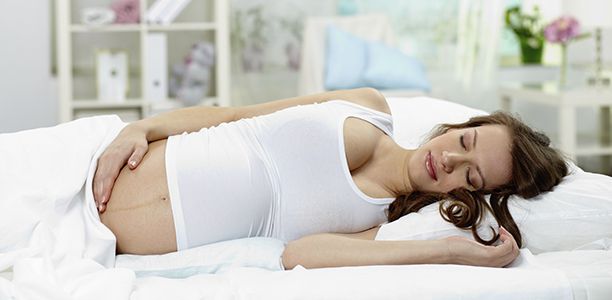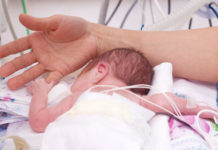Trying to find a comfortable position for a good night’s sleep can be a challenge at the best of times. With a pregnant belly and other pregnancy related body changes, some sleep positions are impossible. Finding the right position, that’s safe for your body and your baby, can be even more difficult.
While sleeping on your back or tummy don’t work with a baby bump, finding the right position for pregnancy sleep is possible with the help of sleep aids like pregnancy pillows and a bit of trial and error. There are plenty of ways you can support your body with pillows, blankets and furniture to make sleeping during pregnancy more comfortable.
Sleeping positions to avoid during pregnancy
During pregnancy it’s best to avoid sleeping flat on your back or flat on your stomach.
Lying flat on your back during pregnancy puts pressure on your intestines and some major blood vessels (known as the aorta and vena cava), because your heavier than usual abdomen rests on them. It’s not recommended during pregnancy after about the 16 week, partly because it’s just uncomfortable, but also because the pressure on your blood vessels may restrict blood flow and make you feel faint. Lying flat on your back can also restrict the flow of blood and nutrients to your baby via the palcenta and your kidney and liver. It can result in complications including:
- Low blood pressure, which may reduce the flow of blood to your heart and to your baby;
- Backache;
- Breathing difficulty;
- Digestive problems;
- Haemorrhoids.
Lying flat on your tummy will become physically impossible as your pregnancy progresses.
How to sleep comfortably on your side during pregnancy
Sleeping on your side is safest for you and your baby during pregnancy because it lowers the risk of restricting blood flow and breathing problems. Sleeping on your left side is best as it can help increase the flow of blood to the placenta that nourishes your baby. Ultimately that means baby will be getting more nutrients while you sleep.
However you have a whole night to get through and you’ll probably find that you sometimes change positions, and may spend some time lying on both your left and right side. Whichever side you choose to sleep, keep your legs bent at the knees and pulled up towards your chest to balance your body and keep your spine straight.
Avoid supporting your weight with your arms as this may reduce blood circulation and cause pins and needles. Crossing your arms over your chest is one way to avoid placing too much weight on them.
Separate your legs by placing a pillow between them or using a full length body pillow.
If you normally prefer lying flat on your stomach or back sleeping on your side may not sound like a comfortable pregnancy alternative. However there are different ways you can support different body parts while lying on your side.
- Place a pillow under your belly for extra support. This may be particularly useful if you’re experiencing back pain during pregnancy.
- Use a pillow to raise your upper body. Raising the upper body is a good way to avoid heartburn. It can also relieve shortness of breath and snoring.
- Sleep with a specially designed pregnancy pillow or bean which offers extra support for your body while you’re sleeping, for example supports the arms, neck and shoulders.
- Apply heat packs to areas of your body that are uncomfortable.
- Place a pillow at the small of your back.
- Use an egg crate type mattress to provide relief to your hips while you’re sleeping on your side.
Pregnancy pillows
There are a range of pillows specially designed to support pregnant bodies and provide support and comfort while lying down. Unfortunately there is little scientific evidence to guide women in the best choice of a pregnancy pillow, or to show whether or not these devices are actually effective in terms of improving sleep or relieving aches and pains that might be worsened with sleep.
A pregnancy cradle is a pillow designed to provide support to the shoulders, neck and arms and help pregnant women maintain a relaxed and comfortable position for sleeping. These pillows come in various densities, depending on whether you like softer or firmer support and are also made to suit women of different heights.
A full body bean pillow provides support to the full length of a woman’s body. It is designed to help a woman sleep comfortably on her side with a baby bump.
Pillows have also been designed which curve to the contours of a woman’s baby bump and sit under the belly to provide extra support while lying on the side. They may relieve back ache and help women get a better night’s sleep.
Alternatives to lying down
 If you have days when you just can’t get comfortable lying down, sitting in a supported position which allows you to rest your body and get comfortable might be a good alternative. For example try:
If you have days when you just can’t get comfortable lying down, sitting in a supported position which allows you to rest your body and get comfortable might be a good alternative. For example try:
- Sitting backward on a chair, with pillows between the back of the chair and your belly to provide support.
- Kneeling in front of an armchair or the head of the bed and bending forward, resting your arms and head on the sofa seat or bed head. Be sure to use pillows to support your knees and upper body.
- Lying on your side and propping yourself up with enough pillows so that you are almost sitting.
Getting out of bed while pregnant
Thinking about how to get yourself out of bed is also important when you’re carrying extra baby weight. You’ll need to get up slowly and make sure you support your body, to avoid putting too much strain on your back, pelvis and belly.
Roll onto one side to begin, then push yourself up gently using your hands and arms. Lower your legs over the side of the bed as you raise your torso.
References
- Pien GW, Schwab RJ. Sleep Disorders During Pregnancy. Sleep. 2004; 27(7): 1405-7. (Full Text)
- American Pregnancy Association. Sleeping Positions During Pregnancy. 2007. (cited 25 September 2014). Available from: (URL Link)
- Queensland Health. A physiotherapy guide to staying comfortable and healthy before and after childbirth. 2010 (cited 30 September 2014). Available from: (URL Link)
- Mayo Clinic. Sleep during pregnancy- follow these tips. 2013 (cited 30 September 2014). Available from: (URL Link)
- American Chiropractic Association. Proper Sleep Ergonomics. 2011. (cited 25 September 2014) Available from: (URL Link)
- National Sleep Foundation. Pregnancy and Sleep. 2014 (cited 30 September 2014). Available from: (URL Link)
- National Health Service. Tiredness and Pregnancy. 2013. (cited 30 September 2014). Available from: (URL Link)
- Medline. Problems sleeping during pregnancy. 2012. (cited 30 September 2014). Available from: (URL Link)
- Woods M. Pregnancy and Sleep: A contradiction in terms? 2014. (cited 25 September 2014). Available from: (URL Link)
- Thomas IL, Nicklin J, Pollock H, Faulkner K. Evaluation of a Maternity Cushion (Ozzlo Pillow) for Backache and Insomnia in Late Pregnancy (and editorial comment). Aust NZ J Obs Gynecol. 1989. (Abstract)
- Cochrane Complementary and Alternative Medicine Field. Ozzlo Pillow for Pelvic/Back Pain in Pregnancy. 2007. (cited 30 September 2014). Available from: (URL Link)
- Women’s and Children’s Health Service- Government of Western Australian. Physiotherapy Before and After Childbirth.2006 (cited 8 October 2014). Available from: (URL Link)



 (5 votes, average: 4.20 out of 5)
(5 votes, average: 4.20 out of 5) 






